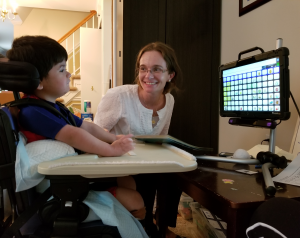 Serve and Return is a term researchers and practitioners use to describe the back-and-forth communication we experience when we interact and respond to one another. It is essential in early development, and starts the first time your infant locks eyes with you and you smile back. The infant locking eyes with you is the serve – the opening of a communicative chain- and you respond to the infant’s communication attempt with a smile – the return. This simple interaction – two way, reciprocal communication – is where children start to learn patterns from their environment. It is where the neurons in the brain start forming connections with one another, based on the repeated discoveries of “when I smile at mommy she smiles back.”
Serve and Return is a term researchers and practitioners use to describe the back-and-forth communication we experience when we interact and respond to one another. It is essential in early development, and starts the first time your infant locks eyes with you and you smile back. The infant locking eyes with you is the serve – the opening of a communicative chain- and you respond to the infant’s communication attempt with a smile – the return. This simple interaction – two way, reciprocal communication – is where children start to learn patterns from their environment. It is where the neurons in the brain start forming connections with one another, based on the repeated discoveries of “when I smile at mommy she smiles back.”
As children get older, the serve and return transfers from those small gestural interactions to bigger, more obvious “serves”. Now this happens when our children hold our hands, they say hi, or when they ask for a snack. They can openly talk about what they see in a book. They serve to us when we do not want them to, like when they wake us up in the middle of the night because they had a bad dream. We do not have to be the communication detectives we were when our children were younger, less verbal, and unable to control their gross motor movements.
Yet children like Joey, whose development is not typical, may experience a growing cognitive ability while the ability to clearly initiate communication experiences more incremental changes. As these children grow older we risk forgetting the importance of serve and return because the cues are harder to observe and more unlike their typically developing peers.
So how do we bring serve and return to Joey and kids like him? Joey can’t open a conversation with us by saying hi, and when we ask him how he is, he can’t say “I’m great!” or, “I’m having a bad day because I had to go to the doctor” like other kids his age. While he’s getting more intentional direction with his arms, he still has some difficulty pointing across a room to show you what he wants, or taking your hand to get your attention. After all, to do that you need to be right next to him.
What’s dangerous with kids like Joey is that it’s easy for us to forget the essential need for back and forth communication. We create a pattern of giving directions and expecting him to follow, or talking to him and wanting him to sit for a long time. As teachers, we can deliver knowledge this way, but we can’t build knowledge, or work on his brain development when we’re talking at him instead of with him.
Instead, we have to be careful to slow down and study Joey’s ability to “serve” to us. What ways is he initiating interactions with us? What is he saying to us? When he looks at us and grins, are we responding as though he is serving to us? Are we returning that serve? Even more important, are we serving to him and expecting him to respond, and honoring it when he does?
We’re starting to notice a pattern in Joey’s communication data. While he may not be using the AAC device when I want him to, his use of gestural and oral language communication is increasing. It seems that in providing opportunities for him to respond with the AAC device, we’ve created the pattern and expectation that we are going to engage in “serve and return” (both for him and for the us.) In doing so, we’ve given him the power of back and forth communication. We’ve opened the door for him to respond to us, and he is responding, sometimes with oral words instead of on the device, or with gestures and pointing. On my last session with Joey I really wanted him to use the eye gaze device to say the word “Four”. Instead, he looked at the number on the screen for a long time before orally said “Four”.
Communication comes in many different modalities, and Joey is using all of them to get his point across, as long as we are listening.


